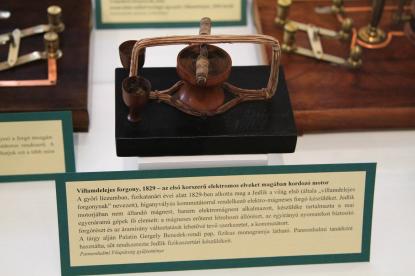2025. April 24. Thursday
Hungarian Museum for Science, Technology and Transport - Hungarian Electronic Museum - Budapest
|
|
Address: 1075, Budapest Kazinczy u. 21.
Phone number: (1) 342-5750
E-mail: info@emuzeum.hu
Opening hours: Tue-Fri 10-17, Sat 10-16
|
The exhibition has closed for visitors.
2011.10.13. - 2011.12.31.
Museum tickets, service costs:
|
Ticket for adults
|
400 HUF
|
|
|
Ticket for students
|
200 HUF
|
|
|
Group ticket for students
|
200 HUF
|
/ capita
|
|
Ticket for pensioners
|
200 HUF
|
|
|
Ticket for families
(2 adults + min. 2 children)
|
1100 HUF
|
/ family
|
|
Group guide
(1-5 people)
|
400 HUF
|
|
|
Group guide
(6-20 people)
|
3500 HUF
|
|
|
Group guide
(from over 20 people)
|
5500 HUF
|
|
|
Group guide
(1-5 people)
|
600 HUF
|
|
|
Group guide
(6-20 people)
|
6500 HUF
|
|
|
Group guide
(from over 20 people)
|
8500 HUF
|
|
|
Photography
|
500 HUF
|
|
|
Video
|
1200 HUF
|
The Museum of Electro Technology is to commemorate the inventor of dynamo, the Benedictine priest Ányos Jedlik. 180 rotating devices, the original 150-year-old dynamo, the 140-year-old lightning-magnetic self-rotor, or the machine that drew pictures of the beginning of waves Jedlik made 135 ago are all on display. Several of the machines will be shown in operation.

The Benedictine priest Ányos Jedlik was born 150 years ago. He made the first uni-polar generator in 1861 to which the magnetic field had electromagnetic origins. This was the machine that directed him to the understanding of the principle of the dynamo five years before the German Siemens and the Englishman Wheatstone. The principle was the beginning of new type of generators.
In addition to the history of the principle of the dynamo, the exhibition is also to reveal the work of Jedlik in other fields, too. Around 1830 he studied in detail all possible electrodynamics rotating methods. He made a number of electric motors. He successfully applied knowledge on electromagnetism and electrostatics. The result of this was the lightning-magnetic self-rotor. In 1855 he made an electric locomotive and also brought the galvanic battery to perfection, his inventions were internationally acknowledged. Most of his works were in the field of electrotechnology, but also did excellently in precision-engineering and the study of light.
In addition to items from the museum collection, the organizers also added some from school equipment stores that are somewhat related to the life and work of Jedlik.
Museum Pedagogy activities and programs accompany the exhibition at the Museum of Electro Technology where the participants may even make their own electric motor after the Jedlik prototype.

The Benedictine priest Ányos Jedlik was born 150 years ago. He made the first uni-polar generator in 1861 to which the magnetic field had electromagnetic origins. This was the machine that directed him to the understanding of the principle of the dynamo five years before the German Siemens and the Englishman Wheatstone. The principle was the beginning of new type of generators.
In addition to the history of the principle of the dynamo, the exhibition is also to reveal the work of Jedlik in other fields, too. Around 1830 he studied in detail all possible electrodynamics rotating methods. He made a number of electric motors. He successfully applied knowledge on electromagnetism and electrostatics. The result of this was the lightning-magnetic self-rotor. In 1855 he made an electric locomotive and also brought the galvanic battery to perfection, his inventions were internationally acknowledged. Most of his works were in the field of electrotechnology, but also did excellently in precision-engineering and the study of light.
In addition to items from the museum collection, the organizers also added some from school equipment stores that are somewhat related to the life and work of Jedlik.
Museum Pedagogy activities and programs accompany the exhibition at the Museum of Electro Technology where the participants may even make their own electric motor after the Jedlik prototype.
